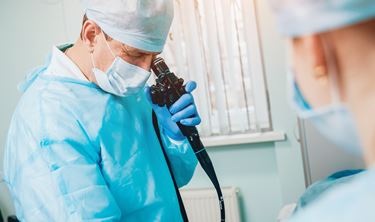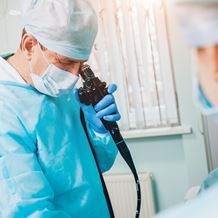Patient resources Diverticular Disease

Important information for all patients
Please read prior to admission
What is diverticular disease?
This condition affects the lining of the bowel in the large intestine or colon wall. It causes small pouches, or diverticula, to protrude from the outside wall of the colon. The condition of having diverticula is known as diverticulosis. Only about a quarter of people with diverticula develop some symptoms of disease.
When diverticula become infected and inflamed, the condition is called diverticulitis. Diverticulitis can vary in severity from a mild attack and a few days of feeling unwell to an emergency requiring admission to hospital.
Who develops diverticular disease?
The condition is very common. While it is rare before the age of 35, the incidence increases with age. One third of Australians over 45 years of age, and two thirds over 85 years have some diverticular disease. Many are unaware they have it.
Causes and predisposing factors
Low-fibre intake is considered the main risk factor. Less fibre increases constipation, and results in harder compact stools which require more pressure to push them along the colon. This pressure may lead to ‘blow-outs’ and formation of pouches. People who eat a diet high in fibre are much less likely to develop diverticular disease.
Common symptoms
Diverticulosis
Most people with diverticula do not have any discomfort or symptoms. Some may have symptoms including mild cramps, bloating, constipation or diarrhoea. As other conditions such as irritable bowel syndrome (IBS) may cause similar symptoms, prompt assessment by a doctor is recommended.
Diverticulitis
The severity of symptoms depends on the extent of the infection and complications. The most common symptom of diverticulitis is constant abdominal pain in the lower left side of the abdomen. It is also associated with changed bowel habits such as constipation or diarrhoea. Infection may cause fever, nausea and vomiting. Some blood may be mixed with the stools.
The symptoms of diverticulitis settle once the inflammation is controlled. It is unusual for a person to suffer more than one attack of diverticulitis in their lifetime. If more than one attack occurs then the risk of ongoing problems is around 70-90%.
Possible complications of diverticulitis
Although rare, serious complications may be life-threatening and usually require emergency hospital treatment. Possible complications include:
- bleeding from the bowel
- a blockage (obstruction/ stenosis) of the colon
- an abscess (a collection of pus) that may form in the abdomen
- a channel (fistula) that may form between other organs such as the bladder
- perforation (hole) in the wall of the bowel that can lead to infection inside the abdomen (peritonitis)
Diagnosing diverticular disease
Diverticula can readily be seen on barium enema or endoscopy (flexible sigmoidoscopy or colonoscopy). Diverticulosis is generally diagnosed during routine screening for colorectal cancer or during tests for other intestinal problems. Diverticulitis is usually diagnosed on clinical examination during an acute attack and is usually confirmed on a CT scan (a form of x-ray of the abdomen).
Treatment of diverticulitis
Treatment focuses on clearing up the infection and inflammation, relieving pain, resting the colon, and preventing or minimising complications.
If treated early, an attack without complications may respond to antibiotics within a few days. A low-fibre or fluid-only diet may help rest the bowel. Fibre intake can be gradually increased to recommended levels (30 grams/day) once recovery is complete. Mild pain relief may be required (e.g. paracetamol).
Patients with severe or acute diverticulitis often require hospital admission and antibiotics plus fluids to be given directly into a vein via a ‘drip’. Stronger pain relief may also be needed.
A small number of people with complicated disease (bowel perforation, abscess, fistula, multiple attacks, uncontrollable bleeding or peritonitis) may require surgery to remove the diseased segment of colon.
Emergency surgery is needed if an attack fails to respond to antibiotics. A temporary colostomy may be necessary if there is a high degree of inflammation or contamination. It is very rare for a person to need a permanent colostomy. Some may be referred for non-urgent elective surgery, where the diseased area may be removed without the need for a temporary colostomy. Many Australian centres now perform a laparoscopic-assisted (keyhole) procedure. Bowel function and general health return to normal after the operation and recurrence of symptoms or complications are rare.
If left untreated, infection can spread to other parts of the body with potentially fatal results.
Prevention of diverticulitis
A daily intake of 30 grams of fibre is recommended to make stools softer and help prevent constipation. Also, a high-fibre diet may prevent further diverticula forming. The diet must include good quantities of roughage such as fibrous fruits (e.g. apples and pears), vegetables and wholegrain cereals. Baked beans and legumes are high in fibre. A fibre supplement or unprocessed wheat bran can increase fibre intake and provide an additional 4 to 6 grams of fibre each day. Increased water intake to 8 cups per day and regular exercise are also recommended.
Summary
Diverticular disease is common. The main cause is a low-fibre diet. Most people with diverticulosis never have any symptoms and should consume high-fibre diets. Diverticulitis occurs when the diverticula get infected and inflamed. Common symptoms include abdominal pain, fever, nausea and a marked change in bowel habits. Mild attacks of diverticulitis can be treated with rest, a fluid-only or low-fibre diet and antibiotics. Severe cases are potentially life-threatening and may require surgery.
Digestive Health Foundation
This information leaflet has been designed by the Digestive Health Foundation as an aid to people with diverticular disease or for those who wish to know more about this topic. This is not meant to replace personal advice from your medical practitioner.
The Digestive Health Foundation (DHF) is an educational body committed to promoting better health for all Australians by promoting education and community health programs related to the digestive system.
The DHF is the educational arm of the Gastroenterological Society of Australia (GESA). GESA is the professional body representing the specialty of gastrointestinal and liver disease. Members of the Society are drawn from physicians, surgeons, scientists and other medical specialties with an interest in gastrointestinal (GI) disorders. GI disorders are the most common health related problems affecting the community.
Research and education into gastrointestinal disease are essential to contain the effects of these disorders on all Australians.
Further information on a wide variety of gastrointestinal conditions is available on our website – www.gesa.org.au


